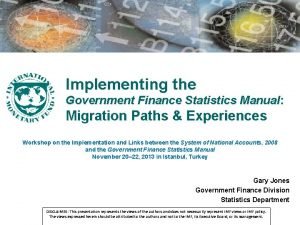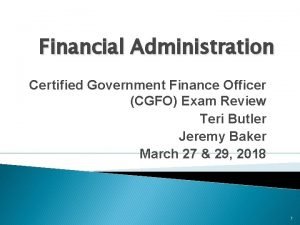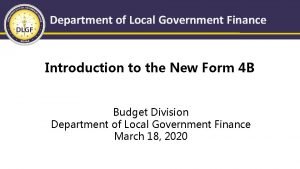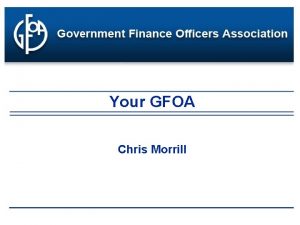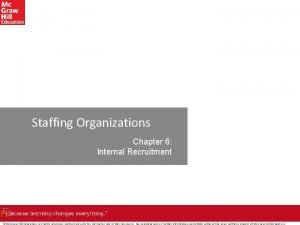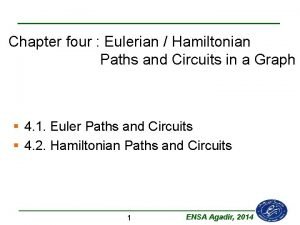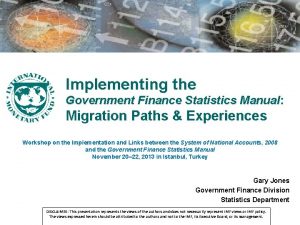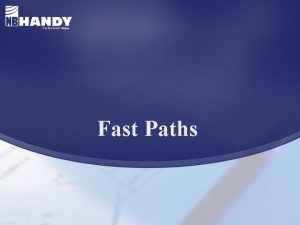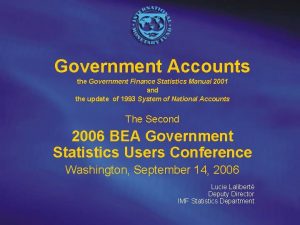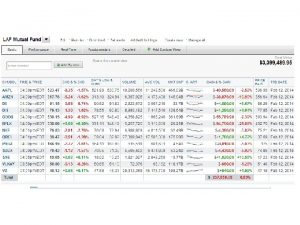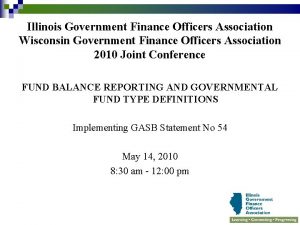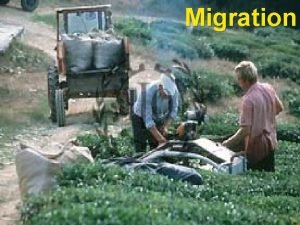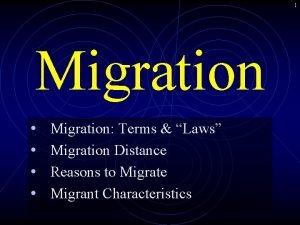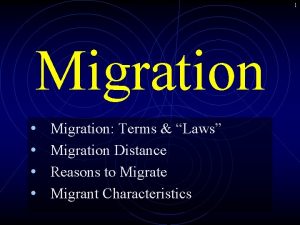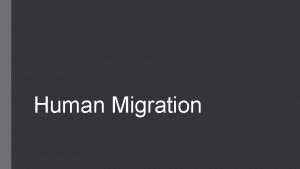Implementing the Government Finance Statistics Manual Migration Paths

















- Slides: 17

Implementing the Government Finance Statistics Manual: Migration Paths & Experiences Workshop on the Implementation and Links between the System of National Accounts, 2008 and the Government Finance Statistics Manual November 20– 22, 2013 in Istanbul, Turkey Gary Jones Government Finance Division Statistics Department DISCLAIMER: This presentation represents the views of the authors and does not necessarily represent IMF views or IMF policy. The views expressed herein should be attributed to the authors and not to the IMF, its Executive Board, or its management.

Contents of Lecture Introduction Factors to take into account for migration path Alternative bases of accounting Country-specific steps needed in development of migration path Possible migration paths Migration experiences May be different from country to country May be different from institution to institution Government Finance Division, IMF Statistics Department 2

Introduction (1/2) Implementation of fully integrated Government Finance Statistics (GFS) system will Take time and resources Need to progress at pace determined by differing needs and circumstances of country involved Governments of most countries will need to revise their underlying accounting systems to reflect Accrual accounting principles; and Classifications of GFS system Government Finance Division, IMF Statistics Department 3

Alternative Bases of Accounting (2/2) Cash basis Bases between cash and full accrual Full accrual A wide spectrum exists For illustrative purposes - consider four points on that spectrum Cash basis Modified cash basis Modified accrual basis Full accrual basis Government Finance Division, IMF Statistics Department 4

Migration from GFSM 1986 to GFSM 2001/13 (2/2) Likely that many countries will broadly follow similar paths as they implement GFSM, e. g. , 1 st step, to classify cash data in GFSM framework 2 nd step, to supplement cash data with additional, noncash information (e. g. , grants in kind) 3 rd step, to supplement cash data with significant accrual information (e. g. , interest) 4 th step, to implement accrual accounting system Government Finance Division, IMF Statistics Department 5

Implementation of GFSM Government Finance Division, IMF Statistics Department 6

Development of a Migration Path (1/7) Six possible development stages 1. Conviction stage 2. Political stage 3. Planning stage 4. Application stage 5. Legislation stage 6. Implementation stage 1. Accounting systems 2. Staff resources 3. User education Government Finance Division, IMF Statistics Department 7

Development of a Migration Path (2/7) 1. Conviction stage What is existing system? • GFSM 1986 format? Budget format? • Shortcomings? What are needs / advantages for country to migrate to GFSM 2001/13 system? • Improvements in government’s policy decisions? • Improvements in accountability? • Greater transparency? • Better economic analysis? • Comparability and consistency What are international demands? • International organizations? Accounting bodies? Government Finance Division, IMF Statistics Department 8

Development of a Migration Path (3/7) 2. Political stage Adequate preparation • To achieve further success • Political will? Possible country-specific factors • Balancing items may seem to deteriorate • Debt position • Misinterpretation – • Emphasize that GFSM 2001/13 provides much improved measures of long term government performance Resistance to change Government Finance Division, IMF Statistics Department 9

Development of a Migration Path (4/7) 3. Planning stage Need a detailed action plan • Spanning several years • Maintain data collection and compilation – Historic links – Parallel runs Cooperation between institutions imperative • Committee representing all relevant institutions and agencies Task forces • Working groups Project and time schedules Government Finance Division, IMF Statistics Department 10

Development of a Migration Path (5/7) 4. Application stage Coverage of units and expense accounts • Choose a recent year’s data; identify government institutional units; rearrange expenditure items and identify accrual items Revenue accounts Assets and liabilities accounts Other aspects • Presentation and legal aspects • Project results, training, etc. • Technical aspects Government Finance Division, IMF Statistics Department 11

Development of a Migration Path (6/7) 5. Legislation stage New legal framework that includes • Timeframe for development stages • Assessment of effects on government accounts Could include reporting requirements and assignment of responsibilities Government Finance Division, IMF Statistics Department 12

Development of a Migration Path (7/7) 6. Implementation stage Depend on migration path A finite task with definite and specific objectives Flexibility to adjust Accommodate new developments as they occur ● ● ● Change classifications in cash accounting system to the GFSM 2001/13 framework Estimate noncash items, e. g. , grants in kind, other payments in kind Adjust time of recording of flows, e. g. , interest Add consumption of fixed capital to Statement of Government Operations Obtain partial data on holding gains (revaluations) and other economic flows, e. g. , foreign loans, debt write-off Government Finance Division, IMF Statistics Department 13

Summary of Progress of the Migration Toward GFSM 2001 Presentation in Staff Reports By IMF Area Department There has been a steady progress with the implementation of the Board decision, and by the end of June 2013, 136 staff reports included the GFSM presentation of fiscal data. This number includes countries with Fund supported programs, and it represents about 70 percent of all staff reports. Source: IMF Staff Reports Government Finance Division, IMF Statistics Department 14

Number of Countries Reporting Data for the GFSY in GFSM 2001 Format Source: Government Finance Statistics Yearbook (GFSY) Government Finance Division, IMF Statistics Department 15

Number of Countries Reporting Data on Assets and Liabilities Source: Government Finance Statistics Yearbook (GFSY) Government Finance Division, IMF Statistics Department 16

GFS Reporting by Country GG – Consolidated General Government A – Accrual or noncash basis of accounting C – Cash basis of accounting F. B. S. – Financial Balance Sheet (Yes / No) Source: Government Finance Statistics Yearbook 2012 Government Finance Division, IMF Statistics Department 17
 Migration
Migration Implementing strategies marketing finance/accounting
Implementing strategies marketing finance/accounting Financial econometrics
Financial econometrics Introduction to statistics what is statistics
Introduction to statistics what is statistics Local government finance
Local government finance Cgfo exam study guide
Cgfo exam study guide Department of local government finance
Department of local government finance Georgia government finance officers association
Georgia government finance officers association State and federal constitutions
State and federal constitutions Internal recruitment definition
Internal recruitment definition Assistant manager career path
Assistant manager career path Algorithm definition
Algorithm definition Life paths research center
Life paths research center List of horticulture careers
List of horticulture careers Single-source shortest paths
Single-source shortest paths Many paths lead to the same destination
Many paths lead to the same destination Single-source shortest paths
Single-source shortest paths Euler path vs circuit
Euler path vs circuit
